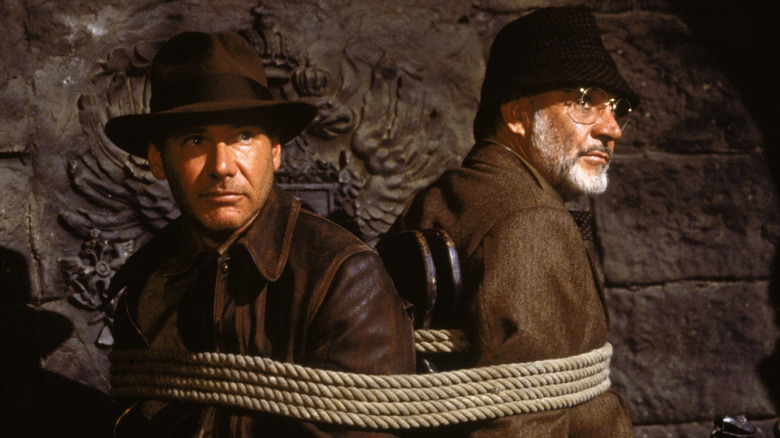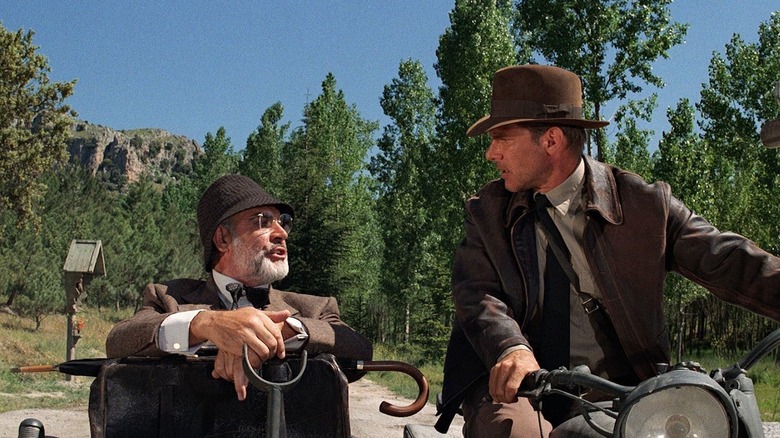Steven Spielberg's Biggest Contribution To Indiana Jones' Story Came In The Last Crusade
You can chart Steven Spielberg's evolution as a director by the "Indiana Jones" films. By 1981, the former wunderkind had gotten the wind knocked out of him by the muted reaction to his erratic 1979 burlesque "1941" (which earned him a tsk-tsking from John Wayne) and was hungry for a rebound. Teaming up with his buddy George Lucas, he made "Raiders of the Lost Ark," a rollicking pastiche that has since supplanted the '30s and '40s serials that inspired their action-adventure in our cultural consciousness.
1984's "Indiana Jones and the Temple of Doom" saw Spielberg wade further into the horror pool he'd explored two years earlier in "Poltergeist," a suburban nightmare that neither he nor director Tobe Hooper can take full credit for. "Temple of Doom" might just feature some of the most exhilarating pacing and grandest spectacle of the filmmaker's career, but that's difficult to appreciate beneath the film's racial insensitivity and general mean-spiritedness. Spielberg, by his own reckoning, wasn't ready to go as dark as he did on that movie, which may explain why its unpleasantness leans more juvenile and less like the handiwork of a storyteller ready and able to grapple with real darkness.
Then came "Indiana Jones and the Last Crusade" in 1989. This was Spielberg at a threshold. With a pair of adult dramas now under his belt ("The Color Purple" and "Empire of the Sun"), he'd already entered a new chapter in his career and was eager to bring a little more nourishment to the table. "Last Crusade" is the most comedic entry in the original "Indiana Jones" trilogy, but its father-son storyline strongly parallels that of Spielberg's strained relationship with his own dad. It's no surprise, then, that this element was also Spielberg's biggest personal contribution to the saga of Henry Walton Jones Jr.
Adding Indy's dad to Last Crusade was Spielberg's idea
Spielberg always puts a little of himself in his movies, and the "Indiana Jones" films are no exception. Even 2008's "Indiana Jones and the Kingdom of the Crystal Skull," for all the flack it gets, allowed the filmmaker to continue his then-ongoing streak of examining morality in the post-9/11 world and wrestling with his own legacy of sensationalizing violence onscreen. It also continued Spielberg's lifelong exploration of fatherhood in his work.
He discussed this in a 2011 interview with Entertainment Weekly, during which he revealed his role in cracking the story of "Last Crusade." Explaining that he's "really proud" of "Crystal Skull" (which maybe he should be), Spielberg emphasized that when it comes to "Indiana Jones," he's "always told George's stories" before adding, "My biggest contribution was adding the father to the third movie. That was my idea, to cast Sean Connery as [Harrison Ford's] father. [...]"
Adding Connery's bookish Dr. Jones Sr. to the equation brings out a whole new side of Ford's plucky archaeologist while at the same time painting him in richer shades than "Raiders" or "Temple of Doom" did. Throughout the pair's interactions, you catch glimpses on Ford's face of the same disobedient schoolboy — played by River Phoenix in the movie's fantastic prologue — whose father would demand that he count to 20 in Greek before interrupting his studies. Their mismatched dynamic and eventual reconciliation is the emotional crux of the film and one of many reasons why it's my personal favorite "Indiana Jones" movie (though I recognize "Raiders" is the best in terms of overall quality).
Spielberg, like Indy, needed to grow up a little, and that's exactly what working on "Last Crusade" allowed him to do.

